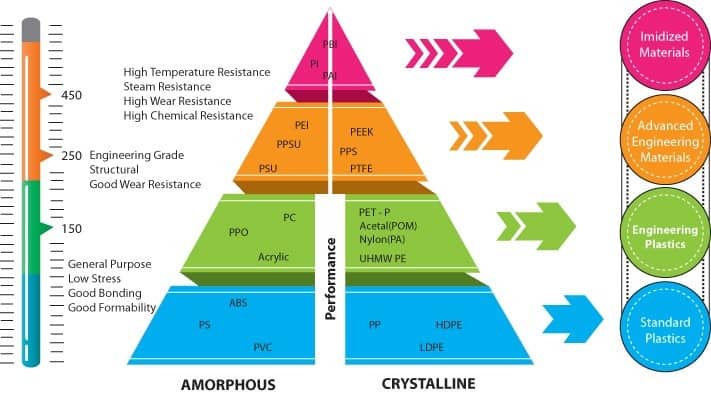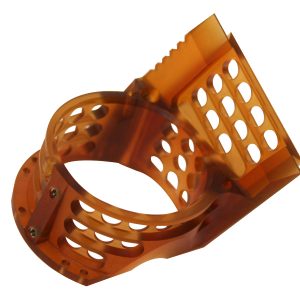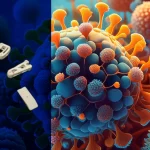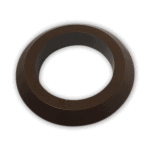An Informational Brief on Polymer Machining
One of the high-performance thermoplastics that AIP works with is ULTEM: a PEI, or polyetherimide. ULTEM was developed by General Electric Plastics Division (Now SABIC) back in the early 1980s. Polyetherimide (PEI) is an amorphous, amber-to-transparent thermoplastic.
Among other uses, ULTEM is popularly used in medical instrument components, aircraft interiors, missile and defense-related components, electrical insulation parts, and semiconductor equipment components.
AIP has over 35 years of experience machining complex components from ULTEM and various other thermoplastic materials. We are providing this Machining ULTEM as yet another insightful technical brief about our polymer component manufacturing process, and how it differs from that of metal machining or injection molding.
Plastic CNC Machining
Before discussing the process of machining ULTEM, it’s important to understand exactly what plastic machining is.
CNC (Computer Numerical Control) machining is a process in the manufacturing sector that involves the use of computers to control machine tools. In the case of plastic machining, this involves the precise removal of layers from a plastic sheet, rod, tube or near net molded blank.
The early history of CNC machining is almost as complex as a modern CNC system. The earliest version of computer numerical control (CNC) technology was developed shortly after World War II as a reliable, repeatable way to manufacture more accurate and complex parts for the aircraft industry. Numerical control—the precursor to CNC—was developed by John Parsons as a method of producing integrally stiffened aircraft skins.
Parsons, while working at his father’s Traverse City, Michigan-based Parsons Corp., had previously collaborated on the development of a system for producing helicopter rotor blade templates. Using an IBM 602A multiplier to calculate airfoil coordinates, and inputting this data to a Swiss jig borer, it was possible to produce templates from data on punched cards.
Parsons’ work lead to numerous Air Force research projects at the Massachusetts Institute of Technology (MIT) starting in 1949. Following extensive research and development, an experimental milling machine was constructed at MIT’s Servomechanisms Laboratory.
Due to the many different kinds of polymers and composites, it’s important to have strong technical expertise of polymer materials when machining plastic components; some plastics are brittle, for example, while others cut similarly to metal. The challenge of plastics is their wide range of mechanical and thermal properties which result in varying behavior when machined. Therefore, it’s important to understand the polymer structure and properties of ULTEM if you’re machining it.
Thermoplastics vs Thermosets
When it comes to polymers, you have two basic types: thermoplastics and thermosets. It’s crucial to know which one you’re working with due to distinct differences between how these two main polymer categories react to chemicals and temperature.
Thermoplastics soften when heated and become more fluid as additional heat is applied. The curing process is completely reversible as no chemical bonding takes place. This characteristic allows thermoplastics to be remolded and recycled without negatively affecting the material’s physical properties.
They possess the following properties:
- -Good Resistance to Creep
- -Soluble in Certain Solvents
- -Swell in Presence of Certain Solvents
- -Allows for Plastic Deformation when Heated
Thermosets plastics contain polymers that cross-link together during the curing process to form an irreversible chemical bond. The cross-linking process eliminates the risk of the product re-melting when heat is applied, making thermosets ideal for high-heat applications such as electronics and appliances.
They possess the following properties:
- -High Resistance to Creep
- -Cannot Melt
- -Insoluble
- -Rarely Swell in Presence of Solvents
Phenolic, Bakelite, Vinyl Ester and Epoxy materials would be considered examples of a thermoset, while ULTEM, PEEK, DELRIN and Polycarbonate materials are examples of thermoplastics.
The thermoplastic category of polymers is further categorized into Amorphous and Crystalline polymers per the figure below:

ULTEM is considered an amorphous, high-performance thermoplastic. Most amorphous polymers are thermoform capable, translucent and easily bonded with adhesives or solvents.
Various Grades of Machined ULTEM
ULTEM PEI (polyetherimide) is a high-strength amorphous polymer. PEI has more than just excellent heat and flame resistance. It can perform continuously up to 340°F thanks to its high flammability rating. That’s not all, though: this polymer is also hydrolysis resistant and highly acid-resistant. ULTEM PEI also outperforms both Nylon and DELRIN with the highest dielectric properties of thermoplastic materials.
While ULTEM is relatively chemical resistant relative to lower end amorphous polymers, you will need to carefully assess the chemical compatibility for the application. This material is also more notch sensitive than RADEL PPSU.
There’s more than one particular type of ULTEM PEI you can machine, and each has slightly different properties for perfecting this material’s use in different applications.
Here are two grades of ULTEM PEI we machine regularly at AIP Precision Machining:
ULTEM 1000

ULTEM 1000 is an unfilled grade of ULTEM PEI. This is considered the “virgin” or “neat” grade of the resin… this basically means no-fillers. It’s well suited to interior aircraft components thanks to its impressive flame resistance and limited oxygen index. Its resistance to UV and gamma radiation and low NBS smoke evolution, low thermal conductivity, and ability to retain 85% of its tensile strength at 10,000 hours of immersion in boiling water make it useful for a variety of structural food processing components. ULTEM 1000 is also FDA, USDA, and NSF-compliant, as well as USP Class VI-compliant.
ULTEM 2300
ULTEM 2300 is a 30% glass-reinforced grade of ULTEM PEI. This gives the high-performance polymer greater tensile strength and rigidity than ULTEM 1000, plus greater dimensional stability, meaning less movement with temperature or load changes. It possesses low thermal conductivity and excellent electrical insulation properties. Additionally, it reacts well to autoclave sterilizations, making it useful for reusable medical applications where repeated cycles are required. ULTEM 2300 is commonly used for structural components where light weight is valuable such as found in many aerospace and defense-related components. ULTEM 2300 is a common direct replacement for aluminum as it has a similar coefficient of thermal expansion to 6061-T6.
Machining ULTEM
Annealing ULTEM
ULTEM can be received in the form of rods, sheets, tube or film. Stress-relieving before machining through an annealing process is crucial, as it reduces the likelihood that surface cracks and internal stresses will occur from the heat generated. This also helps prevent any warping or distortion of your plastic materials.
If the machine shop you are working with does not have a computer controlled annealing oven for plastics, then “head for dee hills” as they are obviously not ULTEM machining experts.
Machining ULTEM
Glass-reinforced ULTEM will require coolants during drilling operations, as they are especially notch sensitive. Non-aromatic, water soluble coolants are most suitable for ideal surface finishes and close tolerances. These include pressurized air and spray mists. Coolants have the additional benefit of extending tool life as well.
Many metal shops use petroleum-based coolants, but these types of fluids attack ULTEM. Many past experiences have shown parts going to customer without cracks, only to develop cracks over time due to exposure to metal machine shop fluids. Be sure to use a facility like AIP who machines polymers and only polymers.
Another difference between glass-reinforced ULTEM and non-filled ULTEM is that non-reinforced thermoplastics can be machined with high-speed steel cutting tools. You’ll want hard metal tools for reinforced materials.
Preventing Contamination
Contamination is a serious concern when machining polymer components for technically demanding industries such as aerospace and medical. To ensure the highest level of sanitation down to the sub-molecular level, AIP Precision Machining designs, heat-treats and machines only plastics, with any sub-manufactured metalwork processed outside our facility.
ULTEM Machining Guide: Supportive Information
Medical Sector Biomaterials Guide
Aerospace Sector Materials Guide






